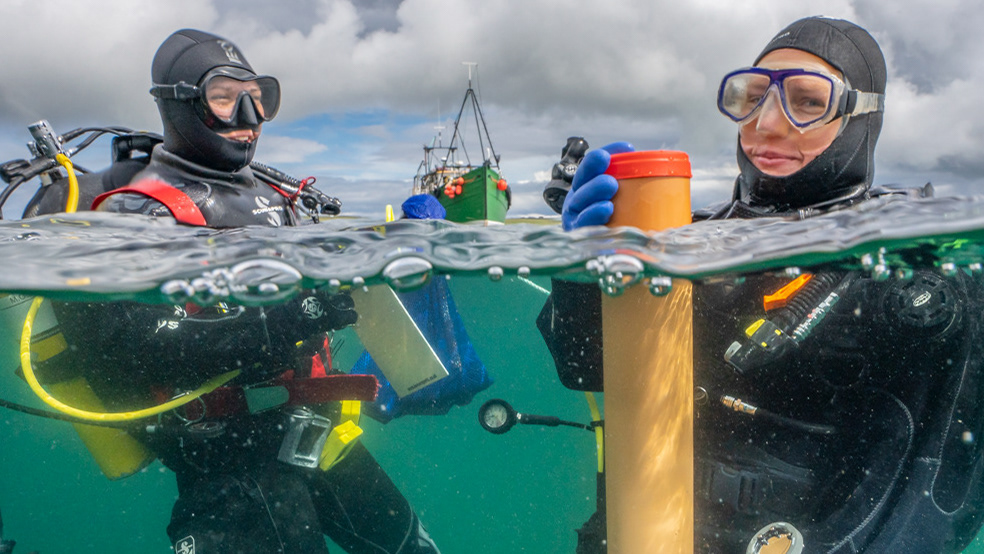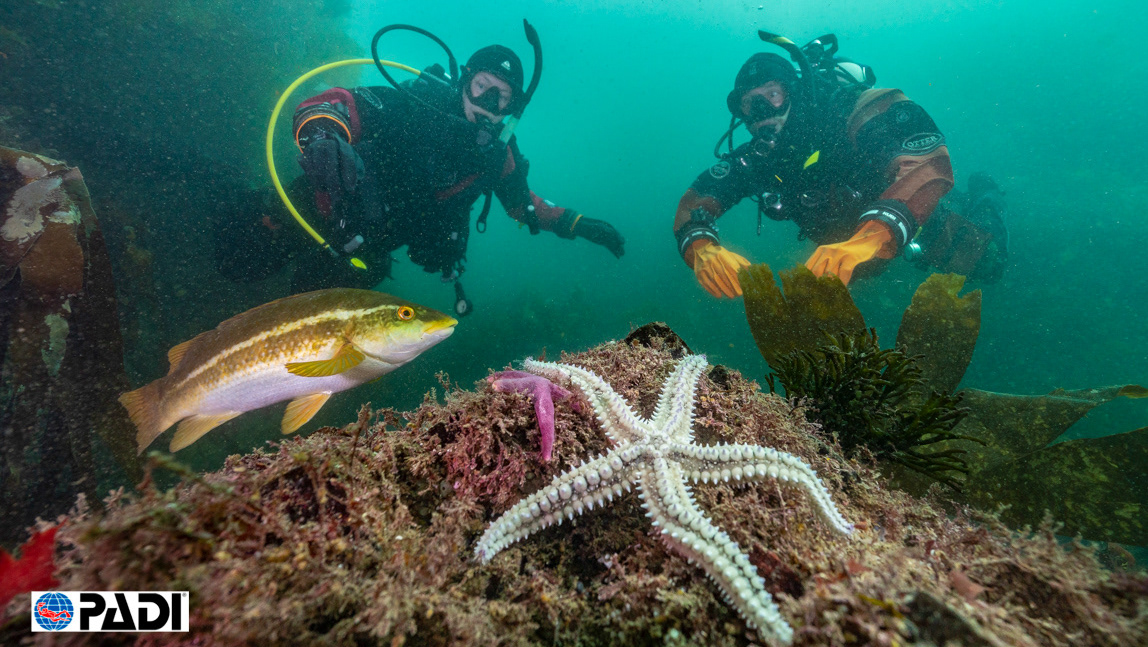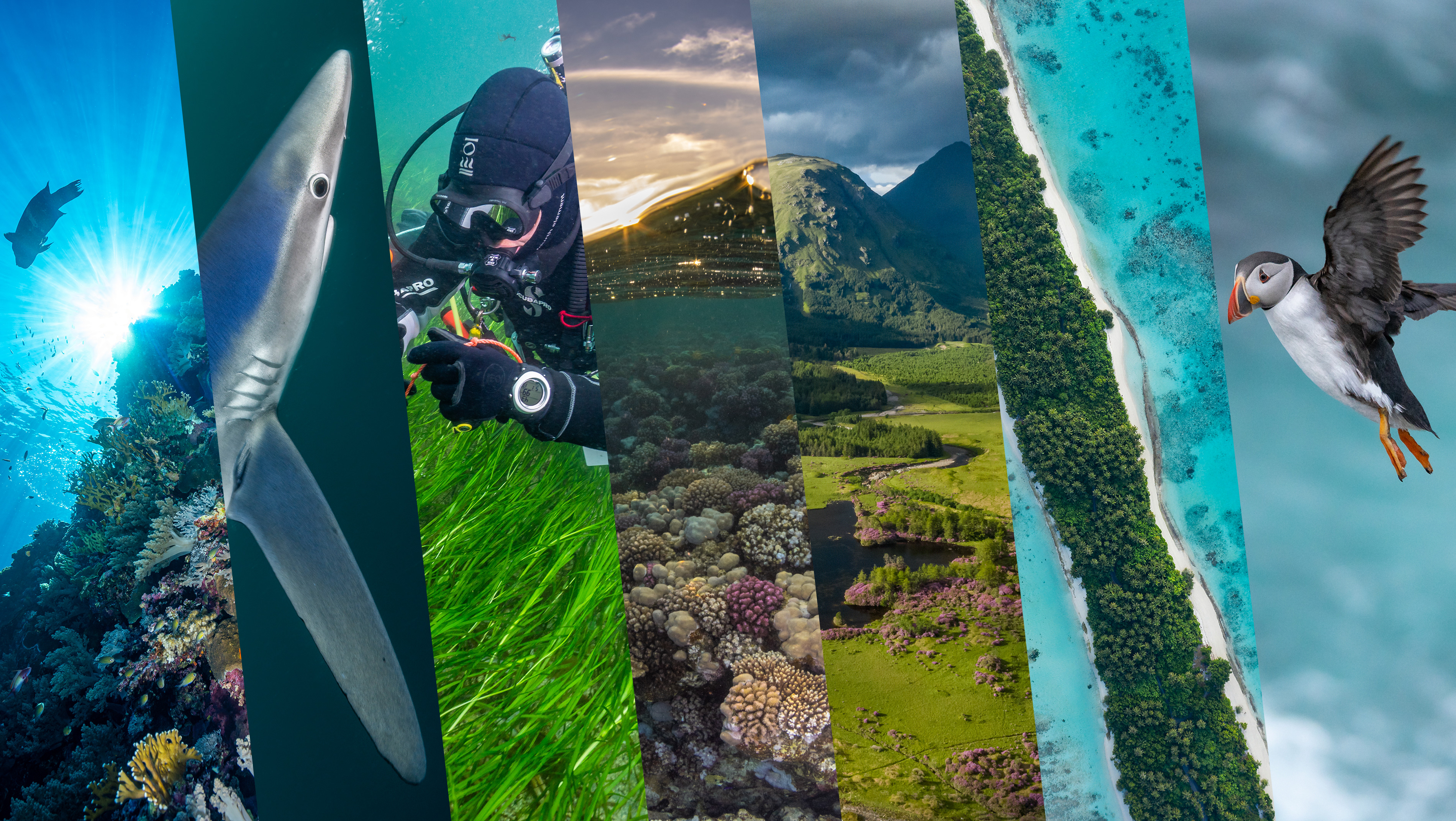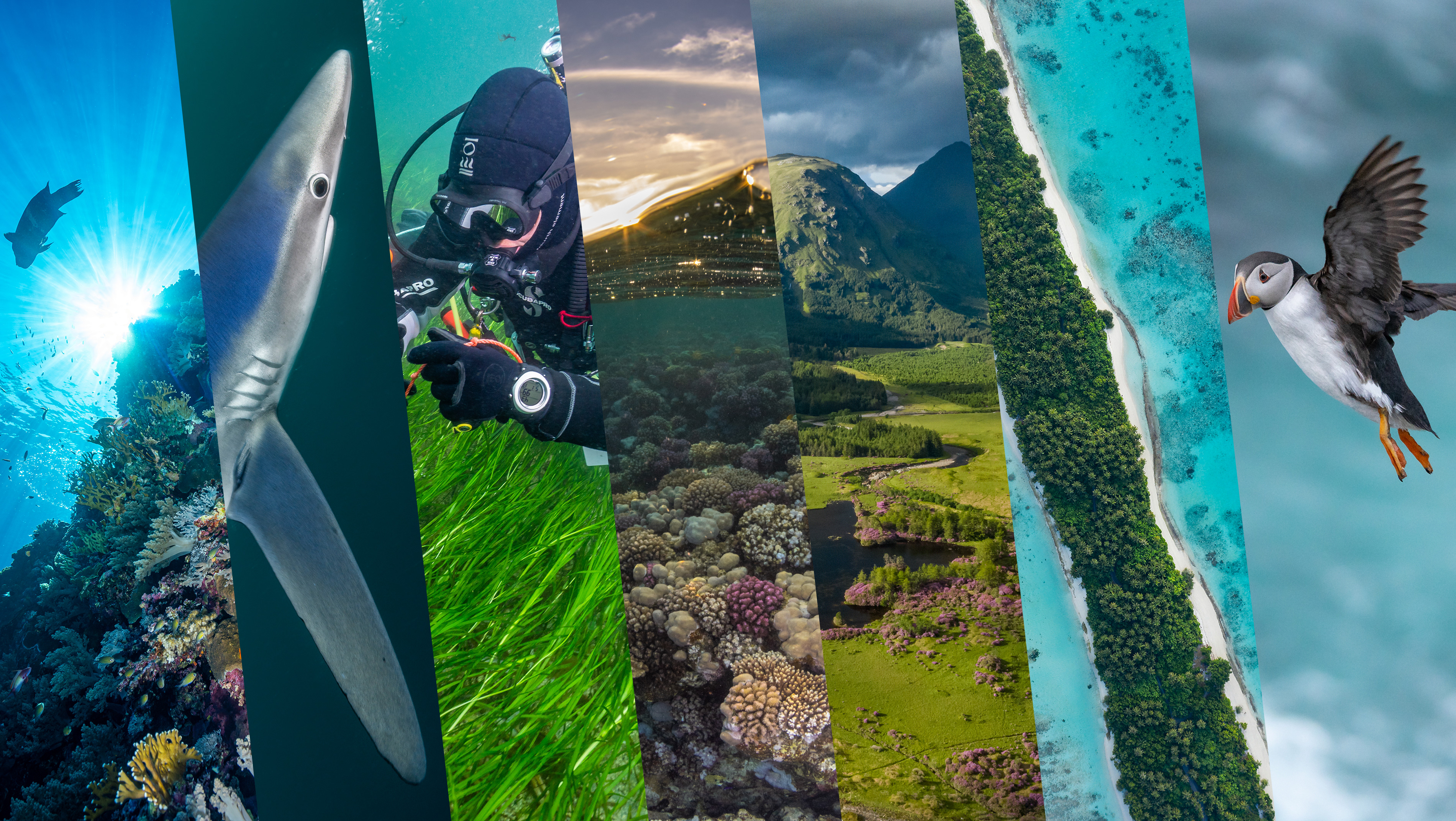WWF-UK Seas programme manager Dr Jenny Oates explores the lush seagrass meadow at Porthdinallean on the North East tip of Wales. The team from Project Seagrass - joined by keen volunteers - collected seeds here in August 2019.
A shoal of juvenile Pollock glide over seagrass at the Helford River in Cornwall. Not only is seagrass important for the health of the ocean it is also hugely beneficial for the economy. Meadows of seagrass provide food and shelter for commercially and economically important species such as these Pollock and also Cod and Whiting. Up to 32% of harvested fish species rely on seagrass meadows at one stage in their lives and the loss of this habitat can hugely affect fish stocks and upset the balance of the ecosystem.
A juvenile Corkwing wrasse peers out from the fronds of seagrass on the Helford River in Cornwall. This colourful, temperate species creates a nest here for their young so they can grow amongst the safety of the seagrass meadow before making their way into deeper waters.
A Small-spotted catshark rests on the seabed amongst a seagrass meadow, beneath the Helford River in Cornwall. Seagrass meadows provide a crucial habitat for these creatures, giving them shelter, food and a place for them to lay their eggs, out of harms way.
Yellow edged polycera (Polycera faeroensis) Nudibranch
Snakelocks Anemones live attached to blades of seagrass swaying back and forth in the movement of the current. They feed by using stinging tentacles to catch prey that drifts by in the water column. These anemones provide a home for other animals such as small crustaceans and shrimps, that can often be found living inside.
A Sea hare searching for food amongst the seagrass in Falmouth Bay, Cornwall. The Sea Hares’ name comes from the upper tentacles on the head which have the characteristics of a Hare’s ears. They can be found amongst seagrass meadows feeding on red algae that attaches to the blades of seagrass which is believed to give them their brown colour. Sea Hares are a food source for commercially important species such as lobsters.
A beautiful Nudibranch (Amphorina farrani) navigates its way up a blade of Seagrass below the Helford river in Cornwall. Seagrass meadows are jam packed full of life and are crucial to the health of our planet.
Marine invertebrates like this Grey top-shell Sea snail use the protection of seagrass meadows to lay their eggs, pictured here is a freshly laid gelatinous ribbon of eggs around the base of the shell. Here, their young can develop in safety with a higher chance of survival than when exposed to the open ocean.
A Two-spotted goby hiding amongst the blades of seagrass. Small and juvenile fish use these thick meadows as shelter from larger, predatory creatures. This lush habitat of vegetation supports a huge level of biodiversity and provides a safe haven for creatures and their young to develop.
A view from the surface shows one of the corroded boat mooring chains descending to the seabed to its anchor amongst the thinning seagrass. As the tide recedes, the chain falls flat and wears a bare patch of sand amongst the meadow as it moves back and forth in the current. The weight of boats on these moorings add yet more movement to the chains.
A small outboard boat engine lies abandoned on the seafloor, flattening an area of seagrass. Over time this engine will corrode in the saltwater, toxic oils and fluids could leak out which would damage marine life for miles around. With increased boating activities, pollution becomes an increased issue for the seagrass.
The movement of the chains back and forth in the current grind away these fragile plants over time, ripping the grass from the sand leaving bare patches amongst the meadow. Environmentally friendly boat moorings have been developed that could become a suitable alternative to these destructive moorings.
An aerial image captured with a drone above the Helford River shows damage from mooring chains to the seagrass under the water. Below each mooring a scar has formed amongst the once-dense cover of vegetation. Seagrass grows in shallow areas close to the coast as it needs plenty of sunlight in order to photosynthesise; it is often found in sheltered areas that make ideal locations for boat moorings - this makes it extremely vulnerable to boating activities and coastal developments.
A marine biologist from Swansea University shows volunteers seed pods on blades of seagrass. Educating the younger generation about the marine environment is key to ensure it is protected over future years. One of Project Seagrass main aims is to educate people on the issues surrounding seagrass and create awareness about the marine environment.
Volunteers of all ages are able to get involved in the programme, it is a great way for people - young and old - to gain an insight into marine conservation and hands on experience. These could be the marine biologists of the future helping to protect and restore our oceans.
As the tide recedes, the snorkel team are able to reach the seagrass again, they fill as many bags as possible before the seeds are transported back to the laboratory for separation from the seagrass. The team aim to collect - an impressive - 1 million seeds during the project.
Working together as a team these young volunteers gather as many seeds as possible before the tide floods back in, which will make it necessary to scuba dive to reach the seagrass.
Scuba diving enables a high efficiency for seed collection as the harvester can get closer down - at eye level - to inspect the blades of grass and pick out the best seed pods. The divers spend up to an hour underwater working hard to gather a large amount of seeds.
Dr Richard Unsworth - a founding director of Project Seagrass and leader of the seagrass ecosystem research group at Swansea University - walks back to shore carrying a harvest of seagrass and seeds that were collected while diving. These seeds will be transported to Swansea University where they will be separated and stored before being transferred to biodegradable hessian bags for planting.
A single blade of seagrass photographed at 20x magnification under a microscope shows a simple, thin plant cell structure. It is more difficult for plants to photosynthesize underwater due to lack of light and carbon, but seagrass has specialized pigments within its cells in order to effectively utilise the limited resources available. Despite this it is extremely efficient at absorbing carbon dioxide and is believed - by scientists - to do so at a rate up to 35 times more than tropical rainforests.
Alex Higgs - a junior member of the Project Seagrass team - siphons out the last of the rotting seagrass mixture from a large cylindrical container used for storing. After the seagrass is collected from the sea it is transferred to these tanks to allow for natural rotting and dropping of the seeds which enables easier seed separation.
Project Seagrass intern Izzy Inman sorts through the seagrass by hand. After the rotting seagrass has been taken out of the large tanks it is then filtered by hand and using gauzes to reduce the plant matter and expose the seeds. The mixture is then transferred to an extraction column where water is pumped through to separate the seeds from the remaining grass. The seeds are negatively buoyant so sink to the bottom of the cylinder and the grass floats up out the top.
Seagrass seeds after the full separation process. Not much larger than a grain of rice, these will now be transferred to a copper sulphate solution and stored in the freezer at zero degrees to prevent fungus forming and prolong germination.
Biodegradable hessian bags that will be filled with a mixture of sand and 50 seagrass seeds before being deployed at the planting site at Dale in Pembrokeshire. The bags will be tied together along a rope connected to the shore; each bag will then be buried in the sand in the subtidal area. Over time the seeds will germinate in the sand and the bags will rot down leaving the seagrass roots to take hold in the sand.
Project Seagrass is a pioneering step in the conservation of this crucial marine plant. If successful and future projects can be backed by government support, this work could be carried out on a much larger scale in the UK and around the world. We could see these lush underwater meadows return to areas where they have been lost, which could help to absorb and store some of the worlds excessive carbon emissions and provide more habitat for precious marine life.











